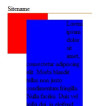Ok, thx mate.
By the way, I'm using JQuery now for hiding and displaying <p>'s, but the weird thing is, it didn't work with the minified version. It does work with the "development version" (the large file), so my code is correct. Any thoughts on that?






